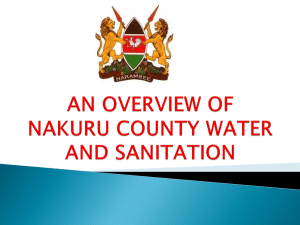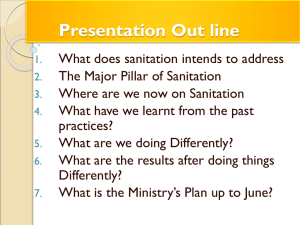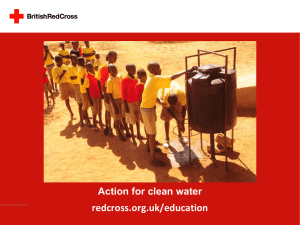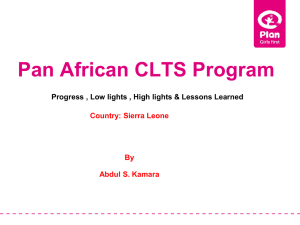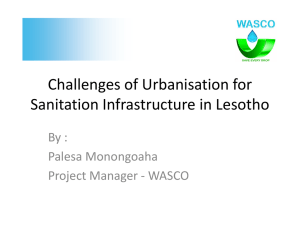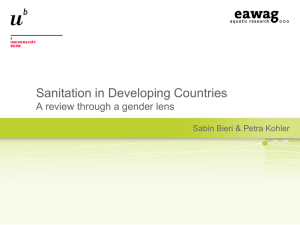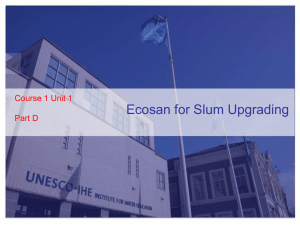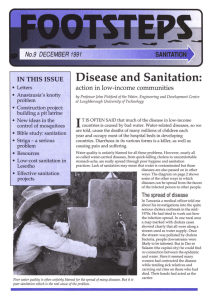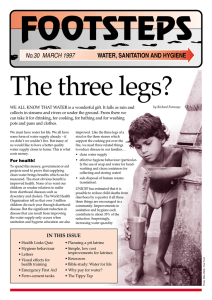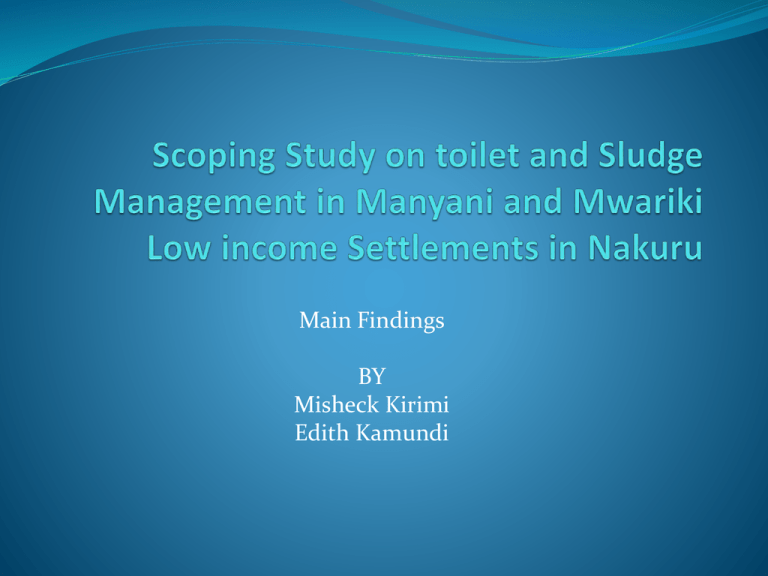
Main Findings
BY
Misheck Kirimi
Edith Kamundi
Scoping Study
Objective:
Assess the factors contributing to poor sanitation
To analyze the impact of poor sanitation on
beneficiaries’ groups and inclusion/exclusion to
other WASH services.
Analyze existing and potential sanitation
innovations and actors
Methodology
Focus Group discussions
Others
1.
Gender
Key Informant Interviews
County government
NGOs
NAWASCO
35
30
25
20
15
10
5
0
Male
Female
Mwariki
Manyani
2. Household questionnaires
3.
Observations/Transect
Walk
Manyani
Mwariki
Source : NAWASCO
Demographics
Nakuru County is the 4th largest town in Kenya with
Nakuru town being the fastest growing town in East
Africa at 13% annually ( UN Habitat 2009)
Populations statistics
Nakuru Town - 500,000
Nakuru Low income areas – 218,216
Mwariki – 24,326
Manyani A – 8894 (County Health Department)
Land Ownership
Manyani and Mwariki was originally ranches land
acquired by residents into smaller plots up to two (2)
acre in size.
Over the years, further subdivisions into much smaller
50x100 sizes
Plot owners organized into association that lobby for
legal status
Ownership is through allotment letters with few
having lease titles.
Landlords are organized into plot owners associations
Basic infrastructure
Road network from Nakuru town into Manyani and
Mwariki settlements is adequate
Housing is mostly permanent stone walled, a few semi
permanent housing made of mud and timber
Number of households per plot minimum 5 to as many
as 150 houses
Water Supply
Approximately 6 % household connection, 66% yard tap
connections, 16% water kiosks and 2 pre-paid meters, rest 10%
kiosks operated by local including pushcart vendors in a few
cases.
Kiosk rate - 20Litre jerry cans - Ksh 2
Vendors - Ksh. 10 to Ksh. 20 per jerry can.
Water Rationing a common few hours a day for specific number
days in a week or limits the quantities of water to households per
week e.g. in Manyani tenants reported a limit of seven (7) jerry
cans per household per week.
To cope, tenants access extra water from vendors supplying water
with donkey carts or water kiosks.
Landlord – tenant relationship
• Own land
• Responsible for
infrastructure within
plot – sanitation,
water
Plot owners
House
Agents/Caretakers
• Act as middle men
for landlords and
tenants
• Collect rent, general
maintenance
• Pay rent
• Users
• Little contact with
landlords
Tenant
Service levels
Sanitation coverage in Nakuru is 59% ( county health
department)
Sewerage coverage is 25% of population served.
Number of latrines
Mwariki A – 1692
Manyani A – 7700
Latrine Technologies
Main technologies in the target settlements
Pit latrines
VIP latrines
Water borne
Pour flush into septic and pits
Pour flush/WC Sewerage connections - NAWASCO and
Private
Technologies
Mwariki
Manyani A
Water
borne
15%
VIP
43%
Simpl
e pit
42%
Water
borne
4%
VIP
38%
No
latrine
10%
Simpl
e pit
48%
Latrine Technologies
Costs of Latrines
A challenge in construction of improved sanitation options was
the high cost of constructing a latrine.
In Mwariki A, it cost the landlords Ksh 170,000 for putting up 3
latrines and 3 bathrooms with septic tanks, in addition to the
Ksh 10,000 approval fees with the county government.
In Manyani making a sewered connection for one door facility
was Ksh 80,000, later on pay sewer monthly charges of 75% of
water consumption.
Operations and maintenance were shared among tenants whose
consumption was quite high.
Pit emptying
Operating Environment
Practices/Activities
Considered illegal
Stigma attached to the
Pit emptying
Collaborating with
practice
Most landlords not willing to
admit use of pit emptying
Nakuru County bylaws, to
include promotion of better
emptying practices
Organised into a group with
savings
Support with protective gear
commercial exhausters to
support removal of solid
waste before exhaustion
Private Sewer unblocking
Emptying/cleaning septic
tanks
Tariffs – from Ksh 500 to
15,000 depending on the
above activities
Defecation Practices
• It is evident that most
residents use toilets
• Little open defecations
• Practised in open spaces by
those few plots within the
settlements without
toilets, or for those where
pit emptying tales too long
• The main challenge is the
adequacy of latrines and
quality of latrines
Where do members of this houseFlying
defecate most of the time? toilet /
peepoo
ple bags
In open
2%
2%
In
latrine
96%
CLTS in Practice….(1)
County Department of public
health trained various PHOs to
implement CLTS
Commenced triggering in
Mwariki, Pembe mbili in Mwariki
already declared ODF, awaiting
verification
Enforcement barriers
1.
Inadequate access on low
income areas
2. Land ownership concerns
3. Harmonization of internal
government coordination
mechanisms
Proposed Strategies
• Sanitation and hygiene policy
and by laws to address gaps in
sanitation such as regularizing
pit emptying.
• County budget allocations for
2014/15/16/17 to support CLTS,
• infrastructure improvement
and demonstration of
sanitation options
• Improve on enforcement
• Lobbying for support through
partners to support county
strategies
CLTS in Practice…..(2)
RRTS (Practical Action and
Umande Trust)
Trained community
mobilisers, PHOs
22 villages triggered by
December 2013
Three (3) declared ODF
Good follow up from PHOs
and CHWs
Improved relationship with
partners
Accompanied by intensive
hygiene promotion
Challenges
Focus not spread to
schools
Triggering mostly
involving tenants in
majority
Tenants have no mandate
for sanitation
‘allowable’ sanitation
options have high cost for
construction
Need for more intensive
hygiene promotion
Existing Mechanisms
Partnerships with K-rep Bank
Landlords form a group of at least five (5) persons and open bank
accounts
Savings of 20% for at least 3weeks before loan is issued, which is
held by bank till full loan is approved
Affordable Interest rate of 15% on a reducing balance unlike
normal loan that is 18.5% flat rate
Members are the guarantors for loan
Initial Loan Approval is done by the group
Umande Trust supports landlords to prepare designs and Bills of
quantities which are verified by the Bank
Bank has assigned a special officer for easier follow up of loan
Repayment period is 2years
Maximum approved so far is Ksh 350,000
Opportunities
Scaling up to other settlements
Including other aspects of sanitation along the
sanitation chain
Other banks can get involved
Solid Waste Management
Period collections in the settlements by licensed
operators
Costs – Ksh 30 per month, collected with Rent
Private operators take garbage to municipal dumpsite
Challenge - There is still evidence of indiscriminate
disposal in drainages, open spaces
Hand Washing Practices
Handwash
facility located
within plot /
premises
12%
Do not wash
hands
4%
Jug / buckets /
cup
84%
Where do you wash your hands while at home?
Gender Issues
Menstrual hygiene – pits, garbage. No special disposal
Landlords participation mainly by men, due to land
ownership structures
Female CHWs sometimes have trouble engaging with
older members of opposite sex
Involvement of youth, except in pit emptying should
be more emphasized – hygiene promotion,
reproductive health education
People Living with HIV/AIDS
Stigma spread to sharing of latrines
Home based care givers not careful in disposal
Mwariki not organized, trouble in advocacy
Manyani is able to advocate for HIV/AIDS issues due
to presence of organized groups
Concern with confidentiality
Elderly and Disabled
Toilets not design for special needs groups
Toilets located at the edges of plots, have to walk a
distance if in a big plot
Lighting is very poor, cannot be easily accessed at
night
Drainage
•
•
A few drainages in
Mwariki and Manyani
areas
Inadequate due to
location of settlements
downstream of Town.
•
Maintenance is poor, full
of solid waste
•
Waste water from
bathrooms, laundry, flows
freely in the settlements
Sanitation and Climate Change
IPCC fifth Assessment report identifies informal
settlements as most affected by issues of climate
change
Reasons: –
Lack of basic infrastructure to deal with inland flooding
such as the case of Nakuru
Increased temperatures can lead to high risks to health,
lack of income
Water scarcity in most urban low income areas due to
congestion – water borne sanitation options
Sector Coordination
ICC platform, present with active members
NAWASCO coordination mechanism of NGOs
Opportunities:-
Engage academia – research, student learning
More private sector – small enterprises in manufacture
of low cost emptying technologies such as gulper
Opportunities
Majority of households already on the sanitation ladder
Infrastructure into the selected targets to allow for
improved sanitation options at settlement level
Ability of landlords to invest in affordable sanitation
options
Willing and enabling working relationship with county
government
Existing financing product
Supporting legal framework – sanitation policy, county bylaws
Existing coordination structure
Barriers
Imbalance in number of toilets vis a vis number of
households sharing
Complex landlord – tenant relationship
High cost of improved sanitation facilities
Geological conditions inadequate for pit latrines
Lack of knowledge/ignorance on laws, regulations
Recommendation

